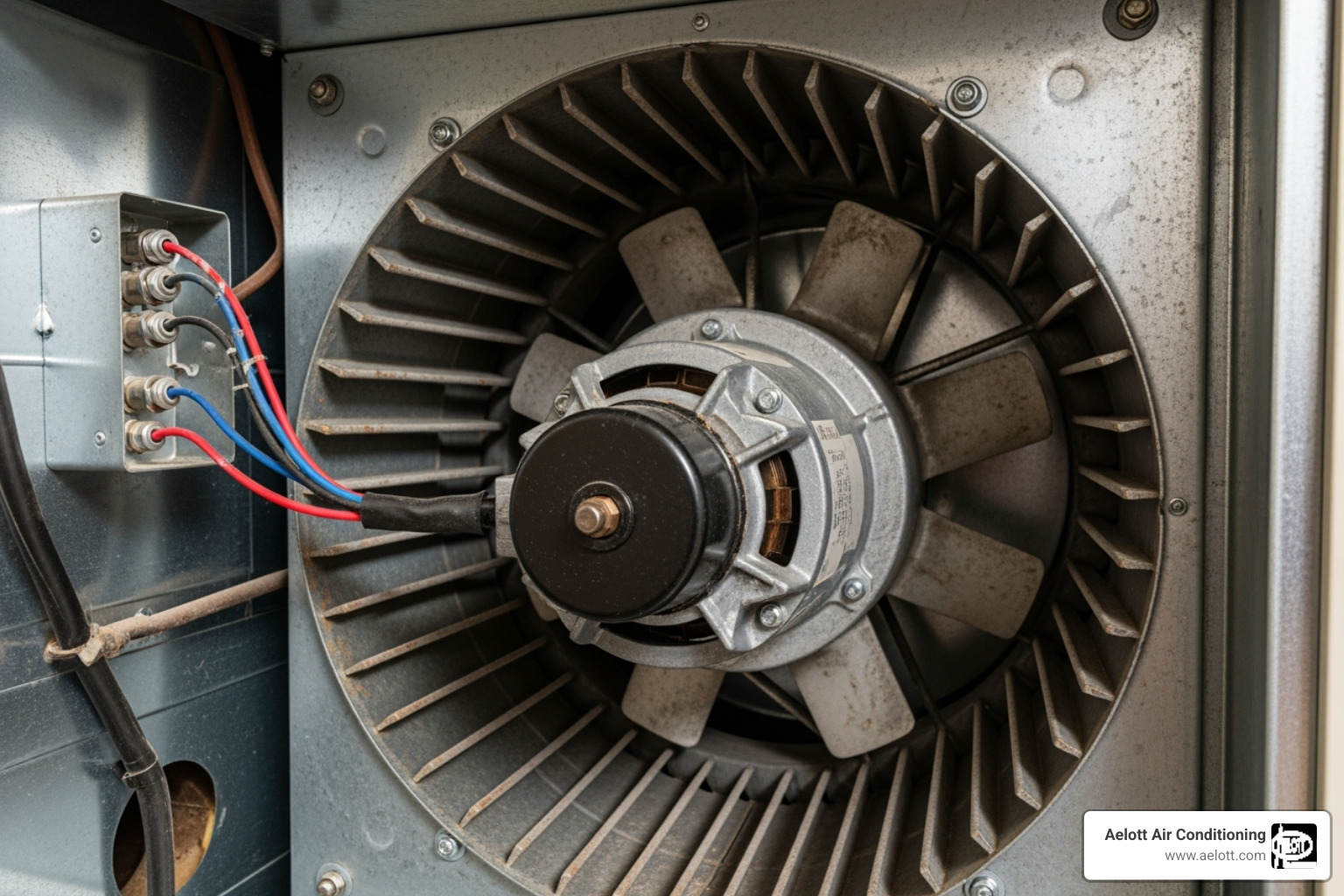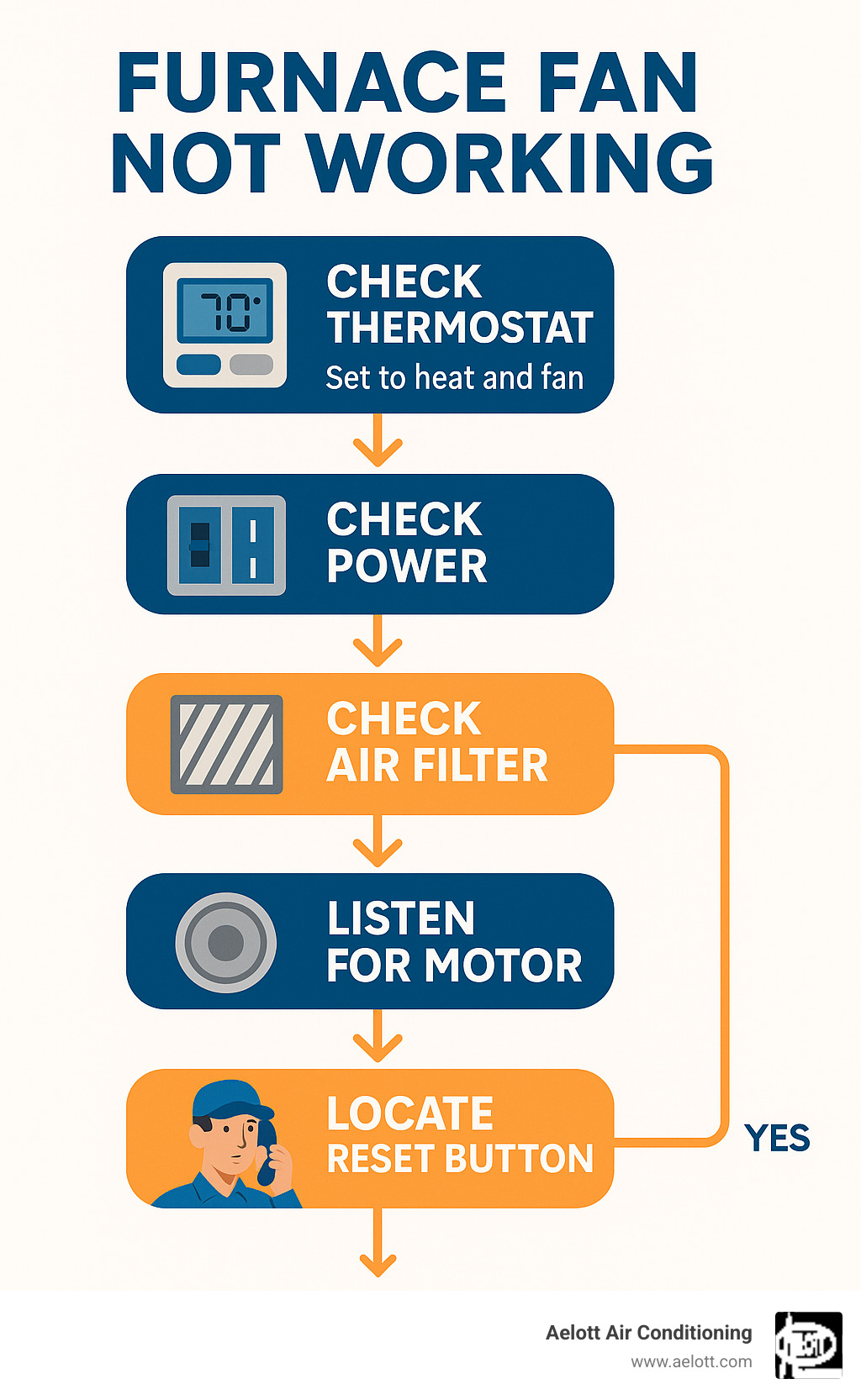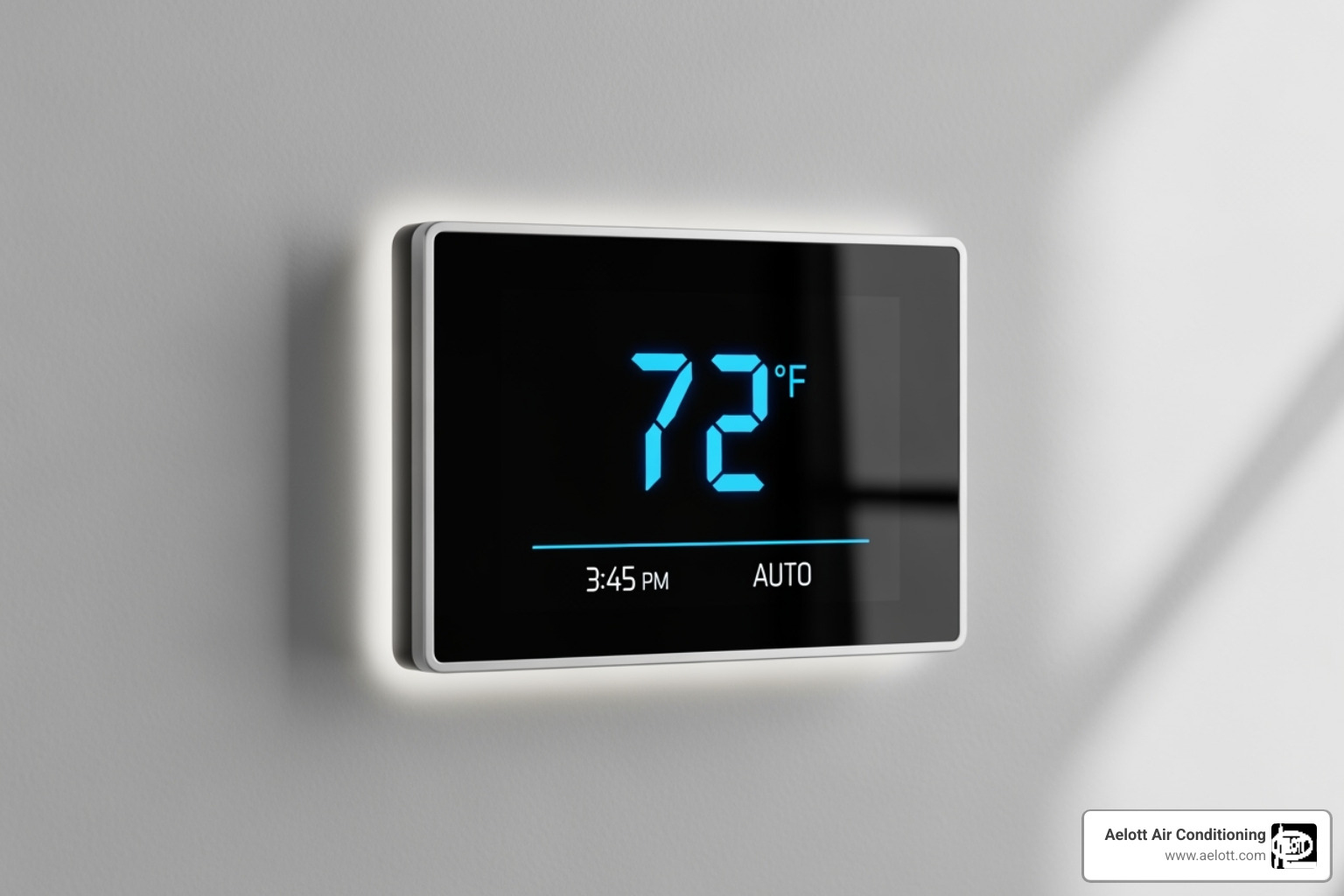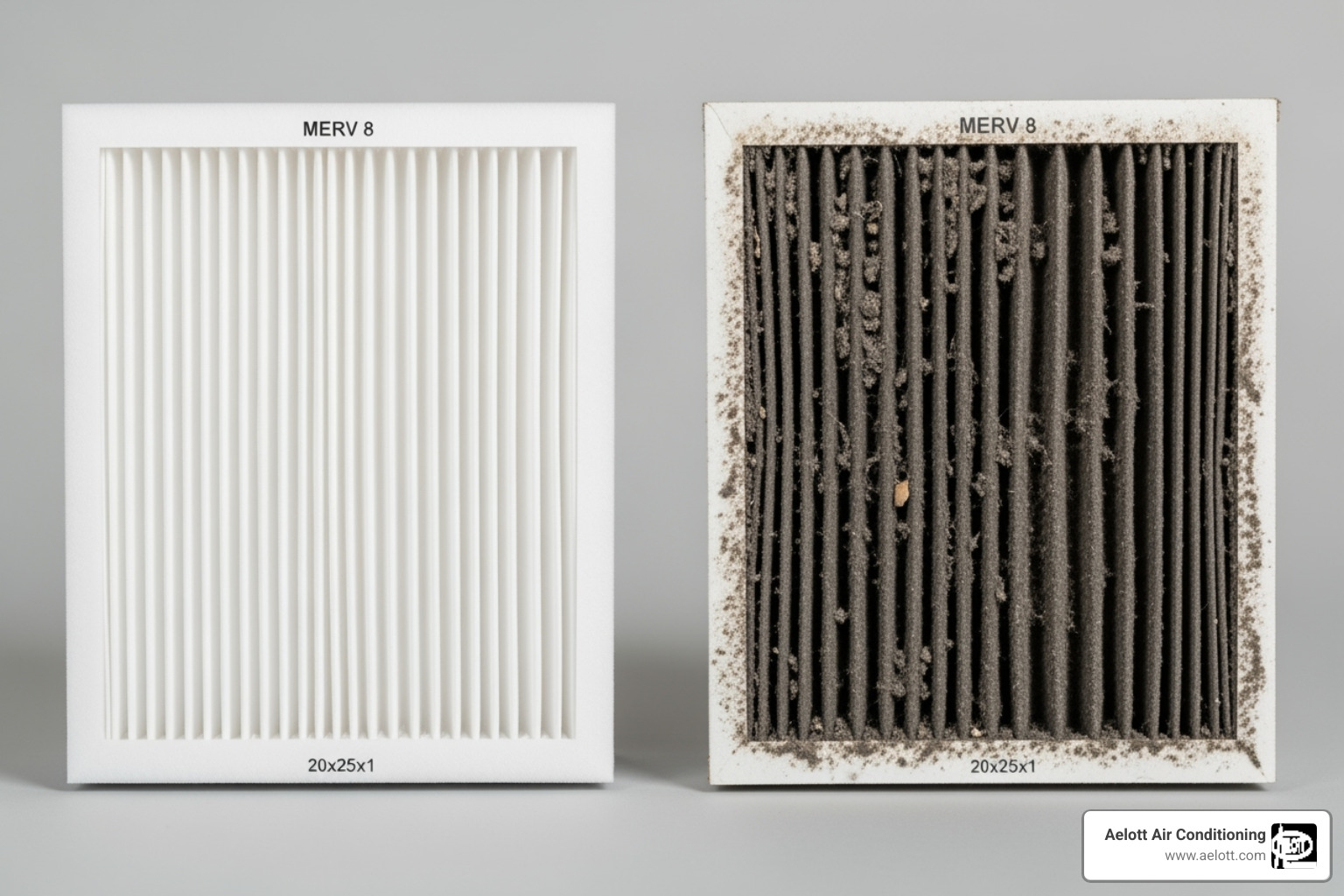.webp)
.webp)
The Silent Fan: Fixing Your Furnace Blower
Furnace fan not working? Diagnose & fix common problems with our DIY guide, or know when to call a pro.

When Your Home Goes Silent: Understanding Furnace Fan Problems
When your furnace fan not working properly, your home's comfort disappears fast. The blower motor that circulates warm air through your house is essential for even heating and proper system operation.
Quick diagnosis for a non-working furnace fan:
- Check the thermostat - Ensure it's set to "Heat" and fan is on "Auto"
- Verify power - Look for tripped breakers or blown fuses
- Inspect the air filter - A clogged filter can shut down the system
- Listen for sounds - Humming usually means a bad capacitor
- Look for the reset button - Try resetting the blower motor
- Call a professional - If these steps don't work
Your furnace fan does more than just blow air around. It pulls cool air from your rooms, pushes it over the heat exchanger, and sends that warmed air back through your ducts. When it stops working, you'll notice right away.
The good news? Many furnace fan problems have simple solutions you can try yourself. Others need professional help to avoid safety risks or further damage.
The research shows that furnace fans typically run for one to five minutes after a heating cycle to distribute air evenly throughout your home. If yours isn't running at all, or running constantly, something's wrong.

Telltale Signs of a Furnace Fan Failure
When your furnace fan not working properly, your home will give you obvious signs. The most glaring indicator is no airflow at all. You'll hear your furnace ignite, but nothing comes out of your vents.
Sometimes you'll get weak airflow instead. Air that barely whispers out of your vents often points to a struggling fan motor or a system fighting against restrictions.
Strange noises are major red flags. A humming sound from the blower area usually means the capacitor has failed—the motor has power but can't get the electrical boost it needs to start.
Squealing or rattling sounds often signal worn motor bearings or loose components. In older furnaces with drive belts, squealing might mean the belt is about to snap.
Another sign that might sneak up on you is increased energy bills. A struggling fan uses more electricity to compensate, and your wallet will feel the difference.
Furnace overheating is a serious issue. Without proper airflow, your system gets dangerously hot and triggers safety shutdowns. Modern furnaces shut down the burners when temperatures climb too high to protect themselves. You might notice the system cycling on and off repeatedly or running the fan continuously to cool down.
Common warning signs to watch for: No air from vents when heat runs, cold air during heating cycles, frequent on-off cycling, unusual furnace noises, higher utility bills, and a furnace that feels hot to the touch.
Don't ignore these signals—they're your home's way of asking for help before a small problem becomes a big headache.
For more details about those mysterious sounds your HVAC system makes, check out what those strange AC noises mean.
Why Your Furnace Fan is Not Working: A DIY Troubleshooting Guide
When your furnace fan not working leaves you shivering, don't panic. Many fan problems have simple DIY solutions. However, the key to troubleshooting is safety first. Furnaces involve electricity, gas, and moving parts, so if you're ever in doubt, call a professional to avoid injury or damage.
What to Check First When Your Furnace Fan is Not Working
Power issues cause more furnace problems than you might think. Always turn off power to your furnace before checking anything, using both the dedicated furnace switch and the circuit breaker.
Your circuit breaker panel is the first stop. Look for any breakers that are flipped to "off" or a middle position. A tripped breaker is a common reason for a furnace fan not working. Flip the breaker firmly to "off," then back to "on." If it trips again immediately, you have a deeper electrical issue that needs professional attention.
Also check your furnace power switch. This light switch-style switch is often located on or near the unit and can be flipped off by accident.
If you have an older furnace, check for a blown fuse. A burnt look or a broken wire inside the glass tube signals an electrical overload.
The Role of the Thermostat
Your thermostat is the brain of your HVAC system, so incorrect settings are a common culprit.

First, check the fan settings. The "ON" setting keeps the fan running continuously, even without heat, while "AUTO" only runs the fan during a heating cycle. For most situations, you'll want it on "AUTO."
Next, ensure the thermostat is set to "Heat" mode and the temperature setting is at least 3-5 degrees higher than the current room temperature. If you have a digital thermostat with a blank screen, it may just need dead batteries replaced.
For more detailed guidance on thermostat troubles, check out our insights on when your AC unit won't respond to thermostat controls.
How a Dirty Air Filter Stops Your Fan
A dirty air filter can cause a furnace fan not working issue. When the filter is packed with dust and debris, it creates severe airflow restriction, forcing the blower motor to work much harder.

This strain leads to overheating. Modern furnaces have a high-limit switch that detects dangerously high temperatures and shuts down the burners to prevent damage. The fan often keeps running to cool the system.
If you hear the fan but get no heat, a dirty filter is a likely culprit. This is an easy and inexpensive fix. We recommend checking your filter monthly and changing it every 1-3 months.
Learn more about the importance of changing air filters regularly to keep your system running smoothly.
How to Safely Reset a Furnace Blower Motor
Many furnace fans have a reset button that can clear minor errors. If you need to reset your blower motor, follow these steps safely.
First, follow the power off procedure: turn off the circuit breaker for your furnace and the dedicated power switch. Wait 5-10 minutes for components to cool.
Next, locate the blower compartment, usually in the bottom section of your furnace, and remove the access panel. Look for the reset button on the blower motor itself—it's typically a small red or yellow button.
This button acts as a manual circuit breaker for overload protection. If it has popped out, push it back in until it clicks. If it hasn't popped out, the reset button isn't the problem.
After securing the access panel, restore power. If the fan works, great! But if the button keeps tripping, there's a deeper issue that needs professional diagnosis.
Deeper Diagnostics: Blower Motor and Component Issues
When the simple fixes don't get your furnace fan not working again, it's time to look deeper. The problem might be hiding in the blower motor's electrical components or mechanical parts. These issues are a bit more complex, but understanding them helps you know what to expect when talking with a professional.
Think of your furnace blower like a car engine - it has several moving parts that work together. When one component fails, the whole system can come to a grinding halt.
The Humming Culprit: A Bad Blower Motor Capacitor
Ever heard your furnace making a humming sound, almost like it's trying to tell you something? That mysterious hum often points to a failed capacitor - one of the most common reasons behind a furnace fan not working.

Picture the capacitor as your blower motor's personal trainer. Just like you might need an extra push to get off the couch and start exercising, your motor needs that initial burst of energy to begin spinning. The capacitor stores electrical energy and releases it in a powerful jolt to get the motor moving.
When you hear that humming noise, your motor is essentially saying "I'm getting power, but I can't get started!" The electrical current is flowing, the motor wants to run, but without the capacitor's starting boost, it just sits there humming in frustration.
A stalled motor like this won't just fix itself. The motor is receiving electricity but lacks the torque needed to overcome its initial resistance and start spinning. It's like trying to pedal a bike uphill from a complete stop - you need that extra oomph to get going.
Here's the critical safety warning: Capacitors store high voltage - often 400 volts or more - even after you've turned off all power to the furnace. This isn't like changing a light bulb. Attempting to handle a capacitor without proper training and equipment can result in a dangerous electrical shock that could seriously injure you.
This is definitely a job for the professionals. The good news? Capacitor replacement is usually straightforward and relatively affordable when done by a qualified technician.
For more insights into the electrical systems that power your home, check out this resource on Understanding furnace power needs.
Is a Broken Drive Belt the Reason Your furnace fan not working?
If your furnace has been faithfully heating your home for many years, it might use an older belt-driven system. While most modern furnaces use direct-drive motors, plenty of reliable older units still depend on a rubber belt to transfer power from the motor to the fan.
Belt-driven blowers work much like the belt under your car's hood. The motor spins a small pulley, which turns a rubber belt, which then rotates the larger blower fan. It's a simple, time-tested design that worked well for decades.
But belts don't last forever. A snapped belt creates a peculiar situation - you'll hear the motor running normally, but absolutely no air comes from your vents. The motor is doing its job, but it's not connected to the fan anymore.
Even before a belt breaks completely, it often gives warning signs. Worn or cracked belts can slip on the pulleys, causing weak airflow or intermittent operation. You might get heat sometimes but not others, depending on whether the belt grips properly.
Those squeaking noises you hear? That's often the sound of a belt crying for help. When belts get old, stretched, or misaligned, they squeal against the pulleys like sneakers on a basketball court. This squealing usually gets worse when the system first starts up and the belt is working hardest.
The silver lining with belt problems is that they're usually straightforward to diagnose and replace. A trained technician can spot belt issues quickly and get you back up and running without breaking the bank.
Understanding Different Fan Types
Not all furnace fans are created equal, and knowing what type you have helps explain both its capabilities and potential problems. Your fan type affects everything from your energy bills to how quietly your system operates.
Single-speed motors are the workhorses of the HVAC world. When they turn on, they run at full power - no adjustments, no variations, just steady, reliable operation. They're like that dependable friend who shows up exactly on time, every time. While they offer basic comfort levels with straightforward on/off heating, their lower energy efficiency means they use more electricity than newer designs.
Multi-speed motors are the step-up option, offering more flexibility with different preset speeds like low, medium, and high. Think of them as having multiple gears like a bicycle. They provide better comfort levels because they can adjust for different heating demands, and their medium energy efficiency falls between single-speed and variable-speed options.
Variable-speed motors are the premium choice, continuously adjusting their speed to match your home's exact heating needs. They're like having a cruise control system that automatically adjusts for hills and traffic. These motors deliver superior comfort levels with consistent temperatures and quiet operation, while offering the highest energy efficiency available.
The type of motor you have also affects what can go wrong. Single-speed motors have fewer electronic components to fail, while variable-speed systems have sophisticated controls that require specialized knowledge to diagnose and repair.
Understanding your fan type helps set realistic expectations for both performance and potential repair complexity when your furnace fan not working properly.
When to Call for Professional Furnace Repair
Let's be honest – we all love a good DIY victory. There's something satisfying about fixing a problem ourselves. But when it comes to your furnace fan not working, knowing when to wave the white flag and call in the professionals can save you from bigger headaches down the road.
Some furnace issues are like changing a light bulb – straightforward and safe. Others are more like performing surgery – best left to the experts. Complex repairs involving control boards, limit switches, motor windings, or cracked heat exchangers require specialized diagnostic tools that most of us don't have sitting in our garage. These components work together in intricate ways, and one misdiagnosis can lead to expensive mistakes.
Safety risks should never be ignored. Anything involving gas lines, high-voltage electrical components (remember those capacitors we mentioned?), or potential carbon monoxide issues requires a licensed professional. Your family's safety is worth far more than the cost of a service call.
The age of your furnace plays a big role in repair decisions too. If your heating system is approaching that 15-20 year mark, throwing money at major repairs might be like putting premium gas in a car that's ready for the junkyard. Sometimes the kindest thing you can do for your wallet is to let go.
Repair costs can add up quickly, especially when you're dealing with multiple failing components. We've seen homeowners spend hundreds on repairs only to face another breakdown a few months later. That's when a conversation about replacement becomes more practical than painful.
At Aelott Air Conditioning, we've been helping families in Escondido and the surrounding areas make these tough decisions since 1963. Our experience has taught us to be straight with our customers about what makes financial sense – whether that's a simple repair or investing in a new system.
Signs It's Time to Replace the Blower Motor or Furnace
Sometimes the writing is on the wall, and that writing says "time for something new." Here are the telltale signs that your furnace fan not working might be the least of your worries.
Age matters more than we'd like to admit. Furnaces typically live good lives for about 15 to 20 years. After that, they start acting like teenagers – moody, unreliable, and expensive to maintain. If your furnace is celebrating its sweet sixteen and having frequent breakdowns, it might be trying to tell you something.
Frequent breakdowns are like a car that needs constant trips to the mechanic. At some point, you're spending more on repairs than the system is worth. If you're seeing us more often than your neighbors, it's time for an honest conversation about replacement.
Rising energy costs can sneak up on you. A struggling furnace works harder to heat your home, and that extra effort shows up in your utility bills. If your heating costs are climbing faster than a mountain hiker, your system might be gasping for efficiency.
Look for moisture damage around your furnace – corrosion on the motor casing, rust on the control panel, or water stains nearby. These are red flags that internal components are breaking down. Water and electricity don't play well together, and neither do moisture and metal furnace parts.
Seized motor bearings make themselves known through grinding noises that sound like someone's torturing metal. If your furnace sounds like it's auditioning for a horror movie soundtrack, the motor bearings have likely given up the ghost.
For more comprehensive information about when your entire system might need replacement, take a look at our detailed guide on signs your AC unit needs to be replaced.
Frequently Asked Questions about a Furnace Fan Not Working
Over the years, we've helped thousands of homeowners in Escondido and the surrounding areas with their heating troubles. Some questions about furnace fan not working issues come up again and again, so let's tackle the most common ones together.
How long should a furnace fan run after the heat turns off?
Here's something that catches many homeowners off guard: your furnace fan is supposed to keep running for a little while after the heat shuts off! Normal operation includes the fan running for one to five minutes after a heating cycle ends.
This isn't a malfunction – it's actually your furnace being smart about air distribution and temperature balancing. Think of it like letting your car engine cool down after a long drive. The fan continues circulating air to distribute any remaining heated air throughout your home and helps cool down the heat exchanger safely.
This post-cycle operation also improves system efficiency by making sure you get every bit of warmth from the heating cycle. Without this cooldown period, you'd lose that residual heat, and your home might develop those annoying hot and cold spots.
Why does my furnace fan run but there is no heat?
This scenario is particularly frustrating because it sounds like everything's working fine, but your house stays cold. When your fan runs but produces no heat, the blower motor is doing its job, but something's preventing the furnace from actually heating the air.
The most common culprit? Your thermostat 'ON' setting. If someone switched the fan setting from "AUTO" to "ON," the fan will run continuously, just circulating whatever temperature air is already in your ducts. It's like having a ceiling fan on in winter – lots of air movement, but no warmth.
Overheating safety shutdowns are another frequent cause. When your furnace gets too hot (usually from a clogged air filter or blocked vents), its safety systems kick in and shut off the burners. The fan keeps running to cool things down, but there's no heat being produced.
A faulty flame sensor can also create this problem. This little component checks whether there's actually a flame in the burner. If it's dirty or broken, it tells the furnace to shut off the gas supply as a safety measure, even though the fan continues doing its job.
Ignition system failures in the pilot light or electronic igniter can prevent the burners from firing up in the first place. No ignition means no heat, but the fan might still run based on the thermostat's commands.
Can I replace a furnace blower motor myself?
We get this question a lot, especially from handy homeowners who tackle other home repairs successfully. While we admire the DIY spirit, replacing a furnace blower motor falls into the "leave it to the pros" category for several important reasons.
Electrical complexity is the biggest concern. Blower motors involve high-voltage wiring and intricate electrical connections that require specific knowledge to handle safely. One wrong connection can lead to electrical shock, damage your furnace's control board, or even create a fire hazard.
The safety hazards extend beyond electrical risks. These motors are heavy, often installed in tight spaces, and require careful handling to avoid injury. Plus, working inside your furnace means navigating around other components that could be damaged if bumped or handled incorrectly.
Specialized tools and knowledge are essential for proper diagnosis and installation. Professional technicians use multimeters and other diagnostic equipment to confirm the motor is actually the problem and ensure the replacement motor is compatible with your specific furnace model.
Professional installation also means getting the job done right the first time. Our technicians know how to properly balance the blower wheel, secure all connections, and test the system thoroughly. They can also spot underlying issues that might have caused the original motor to fail, preventing future breakdowns.
For professional furnace service that you can trust, learn more about our comprehensive More info on professional furnace service. With over 60 years of experience, we've seen every type of furnace fan problem imaginable and know how to fix them safely and efficiently.
Get Your Furnace Fan Working Again
When your furnace fan not working properly, it can turn your cozy home into an uncomfortable space faster than you'd expect. We've covered everything from the obvious signs like no airflow and strange noises to the more complex issues involving capacitors and motor failures.
The good news is that many furnace fan problems start with simple fixes. Checking your thermostat settings, making sure your circuit breaker hasn't tripped, and replacing that dirty air filter can solve a surprising number of issues. These basic troubleshooting steps are worth trying before calling for help.
But let's be honest – some problems need professional attention. When you hear that telltale humming sound indicating a bad capacitor, or when your furnace keeps shutting down for safety reasons, it's time to step back. Electrical components can be dangerous, and trying to fix complex motor issues without the right tools and experience often creates bigger problems.
Here's what we've learned: Simple DIY fixes work great for basic issues, but professional diagnosis becomes essential when dealing with blower motor failures, electrical components, or safety shutdowns. The key is knowing when to try a quick fix and when to call the experts.
At Aelott Air Conditioning, we've been solving furnace problems in Escondido and the surrounding areas since 1963. That's decades of experience dealing with every type of furnace fan not working scenario you can imagine. Our team understands that when your heating system fails, you need honest answers and dependable solutions – not sales pitches or surprise charges.
We back our work with a 100% satisfaction guarantee because we believe in doing the job right the first time. Whether your furnace just needs a simple repair or it's time to consider replacement options, we'll give you the straight truth about what's best for your home and budget.
Don't let a silent furnace fan leave you shivering. Schedule your furnace repair in Escondido, CA with our experienced team today, and we'll get your home back to its warm, comfortable best.

Customer Testimonials
Go With Experience

HVAC Financing Available!
Get 0% Financing for 12 Months with Deferred Interest! Enjoy no payments and no interest on select plans.


Latest Blogs

.avif)
How to Run Your Furnace Efficiently: A Guide to Staying Warm This Winter







